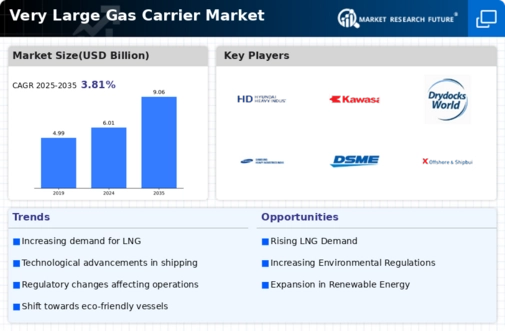Market Growth Projections
The Global Very Large Gas Carrier Market Industry is projected to experience substantial growth over the next decade. With a market value of 6.01 USD Billion anticipated in 2024, the industry is expected to expand to 9.06 USD Billion by 2035. This growth trajectory indicates a compound annual growth rate (CAGR) of 3.8% from 2025 to 2035. Such projections reflect the increasing reliance on natural gas as a cleaner energy alternative and the ongoing investments in LNG infrastructure. The anticipated growth underscores the importance of Very Large Gas Carriers in facilitating global energy trade.
Growing Global Trade of LNG
The expansion of global trade in liquefied natural gas is a key driver for the Global Very Large Gas Carrier Market Industry. As countries diversify their energy sources, the demand for LNG is increasing, particularly in regions with limited domestic production. This trend is reflected in the rising number of long-term contracts and spot market transactions, which are facilitating the movement of LNG across continents. The market's growth is further supported by the increasing number of Very Large Gas Carriers being deployed to meet this demand. This dynamic trade environment is likely to contribute to the overall market growth and stability.
Investment in LNG Infrastructure
Investment in liquefied natural gas infrastructure is a significant driver for the Global Very Large Gas Carrier Market Industry. Countries are prioritizing the development of LNG terminals, storage facilities, and distribution networks to accommodate the growing demand for natural gas. This trend is particularly evident in emerging markets, where investments are being made to enhance energy security and reduce reliance on coal. As these infrastructures are developed, they create a robust ecosystem for LNG transportation, thereby increasing the need for Very Large Gas Carriers. This investment trend is expected to sustain market growth in the coming years.
Increasing Demand for Natural Gas
The Global Very Large Gas Carrier Market Industry is experiencing a surge in demand for natural gas, driven by the transition towards cleaner energy sources. Countries are increasingly investing in natural gas infrastructure to reduce carbon emissions, which is evident in the rising number of LNG import terminals worldwide. This shift is projected to elevate the market value to 6.01 USD Billion in 2024, as natural gas is seen as a bridge fuel in the energy transition. The growing appetite for liquefied natural gas (LNG) in Asia, particularly in China and India, further underscores this trend, indicating a robust future for the industry.
Technological Advancements in Shipping
Technological innovations are playing a pivotal role in enhancing the efficiency of the Global Very Large Gas Carrier Market Industry. The introduction of advanced propulsion systems, improved hull designs, and digital navigation tools are optimizing fuel consumption and operational efficiency. These advancements not only reduce operational costs but also align with environmental regulations aimed at minimizing emissions. As a result, the market is likely to see an increase in the number of new vessels being commissioned, contributing to a projected growth rate of 3.8% CAGR from 2025 to 2035. This technological evolution is essential for maintaining competitiveness in a rapidly changing energy landscape.
Regulatory Support for LNG Transportation
The Global Very Large Gas Carrier Market Industry benefits from supportive regulatory frameworks that promote the transportation of liquefied natural gas. Governments worldwide are implementing policies that encourage the development of LNG infrastructure, including subsidies and incentives for shipping companies. This regulatory environment not only facilitates investments in new vessels but also ensures compliance with stringent safety and environmental standards. As a result, the market is expected to grow significantly, reaching an estimated value of 9.06 USD Billion by 2035. Such supportive measures are crucial for fostering a sustainable and efficient LNG supply chain.



 Source: Primary Research, Secondary Research, MRFR Database and Analyst Review
Source: Primary Research, Secondary Research, MRFR Database and Analyst Review












